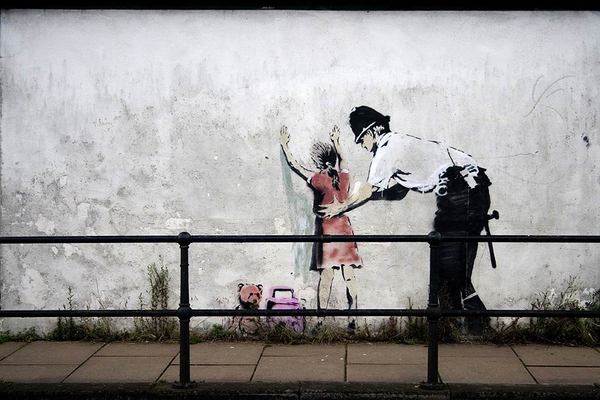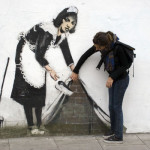By MARISSA MOLINARO
On November 2, 2007, TIME Magazine published an article about British graffiti artist Banksy titled Banksy Unmasked? A Graffiti Mystery, by Alex Altman. The article displays and discusses a pixilated camera-phone image of a man crouched down with a paint brush in front of Banksy's latest piece, as confirmed by the artist's spokesperson. What is still in question, however, is whether or not the man in the photo is in fact the artist whose identity has long been concealed.
The tone of the article is written such that Banksy becomes a mythical and, even worse, mystical creature. According to the author, he "shrinks from cameras like a vampire from the sun" and the possibility of spotting him is likened to "bagging the Loch Ness monster." Realistically, while Banksy's artwork is well known, he maintains the same necessary low-key identity as any other graffiti artist, as he remains prolific on the street. Banksy has also voluntarily and successfully entered the art market, and the author of the article drives a spectacular punch home by slipping in the names of Brad Pitt and Angelina Jolie as a couple of his buyers to really illustrate the weight of the situation. And, naturally, this means he must be good.
The article goes on to discuss the political and witty nature of Banksy's work, citing a few examples. However, the author seems to have completely misunderstood the artist's use of irony, which is latent with tongue in cheek political statements and satirical criticism for sheer contradiction. This paragraph is particularly embarrassing:
His art is often pegged as anti-capitalist or anti-establishment. But he seems gleefully eager to subvert even the most pervasive presumptions about him. For example, while he is generally described as antiwar, at a 2003 peace demonstration in London he reportedly distributed signs reading: "I Don't Believe in Anything. I'm Just Here For The Violence." Banksy specializes in a strange brand of self-promotion: he'll sell six-figure creations and then sermonize on the evils of consumerism. Such behavior doesn't seem to deter buyers. In April, the auction house Bonham's sold his Space and Bird, a spray-painting on steel, for almost $600,000, and recently a set of 10 of his works went for more than $1 million.
I'm not entirely sure that an anti-capitalist artist selling their work can be so demonized, because regardless of what beliefs one maintains and the changes one wishes to make, it is nearly inevitable to continue to take part in the world as it currently stands. I am equally unsure that the kind of consumption within the art market is the same kind of consumerism that Banksy regularly criticizes (see 1, 2, 3,4, 5). And even in the instances that he does point a finger at the art world, as in "Mind the Crap" at the Tate and in this image, it's important to accept the possibility that making a ruckus within the industry with which one is associated can bring important attention to the concern at hand (consider the Guerrilla Girls).
Further, his participation in the 2003 peace demonstration in London is more readable as a satirical criticism of the general public's apathy, intending to be thought provoking and to strike a chord that hackneyed protest procedures can no longer manage to hit, rather than the self-centered playful trickery as interpreted by the author of the article. In missing the underlying concept of the work and suggesting that these contradictions might deter buyers, the author devalues the artist's irony instead of recognizing it as an integral part of the work.
The author begins to question the consequences that public exposure might have on Banksy by first establishing that his work and his notoriety depend on his mysterious covertness. Let's save ourselves this romanticism of "mystique" and accept the fact that Banksy is not putting on a performance with his surreptitious behavior. Although appreciated by some, what he does is illegal, considered vandalism, and is responded to stiffly by many establishments, and it is for this reason that he must conceal his identity. It should go without saying that Banksy's notoriety has little to do with the fact that we don't know what he looks like, and more to do with the cleverness, wit, and awareness he wields upon the public.
What is more interesting than the supposed image of Banksy is to consider who was behind the camera and to contemplate that someone knowingly took (or created) this picture and then gave it to the press, interfering with something bigger than themselves.
Who cares if we know what Banksy's digitized profile looks like? How much does this reveal about him anyway? The only people who would aggrandize something like this are those who like to (or get paid to) perpetuate sensationalism in pop and, sadly, in underground culture. From Banksy, I think the most reaction we might get is just another clipping on his web page.
- Grafitti work by Banksy
- Grafitti work by Banksy
- The author in front of one of Banksy’s most iconic pieces
Banksy
Banksy Unmasked? A Graffiti Mystery in TIME Magazine
Photos: The World According to Banksy, TIME photo essay
Top two images are courtesy of the artists website.
Bottom image courtesy of the author.







